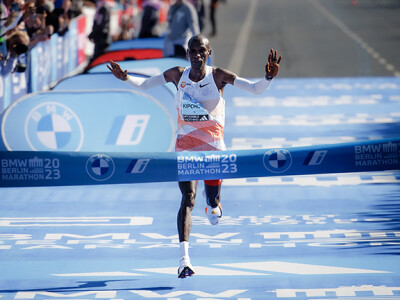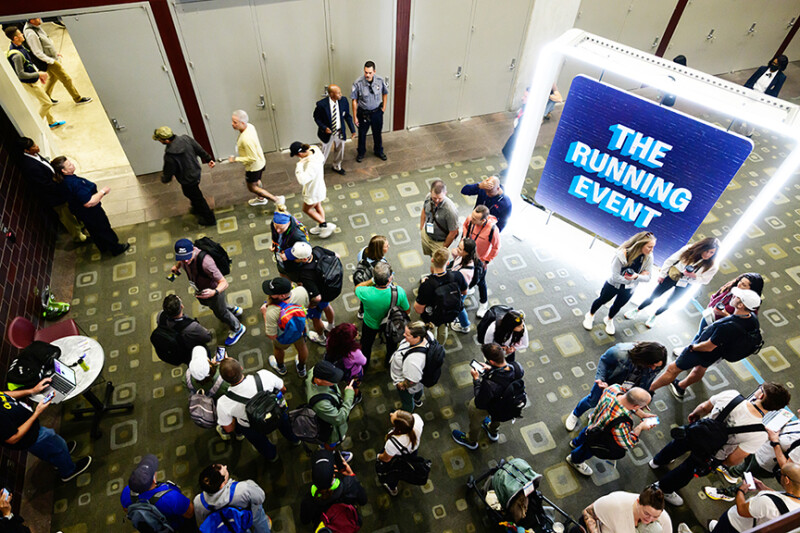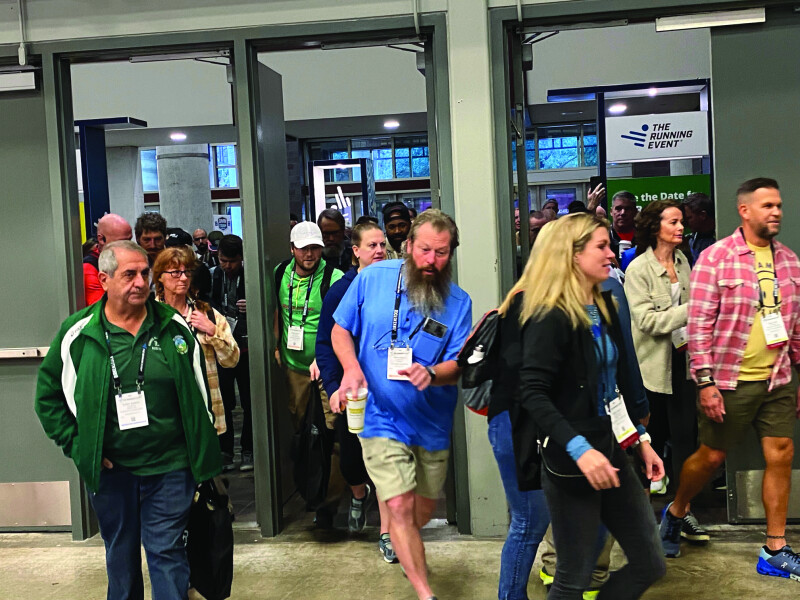There are a number of things that marathons around the world have in common — the distance, the refreshments and the shoes. While terrain and snacks may vary from race to race, the near uniformity of the shoes, at least in concept, has grown in both height and breadth — literally and figuratively. Here four key brands and researchers provide insight while answering our query: “What’s on Your Plate?”
With the better part of a decade bringing us to this point, how many iterations of plated shoes have developed within the brand?
“ASICS entered the plated shoe conversation in 2020 with the Metaracer, introducing our energy-saving Guidesole technology, combined with a stabilizing carbon plate. This was seen on the feet of our elite athletes at that year’s Olympic trials.
“With innovation accelerating rapidly, we followed fast in 2021 ahead of the Tokyo Olympics and introduced our Metaspeed series of carbon plated racers, including the Sky and Edge models to offer athletes the ability to have options to match their style of running. In 2022, the Metaspeed+ Series continued our innovation pipeline and in 2024 the Metaspeed Paris series premiered our fastest shoes yet, featuring a new PEBA foam, rethought carbon plates and geometries to enable our athletes to get to the finish line fast than ever — and on the feet of Clayton Young as he made the U.S. marathon team for Paris.” — Paul Lang, Senior Manager, Merchandising, ASICS North America
“We are currently finalizing our third carbon fiber plate for elite running shoes. Each iteration builds upon the previous concept, while also striving to be unique.
“Our first plate, designed for the Ultra Carbon, focused on versatility and durability. We innovated with a unique split-toe design that provided out-of-the-box comfort and enhanced performance on various surfaces, making it the first road-to-trail super shoes on the market.
“The Nordlite Speed evolved from the insights gained from the first plate, resulting in a road-only shoe that has become a favorite among elite athletes and everyday runners alike.” — Eric Sarin, Craft Design & Engineering team
“The technology has been available for many years, but the combination of systems, improved designs and Air Zoom is a vital component to the aggregate of the technologies. The Alphafly combines each component with the carbon plate, which has the benefit of being light, responsive and stiff, along with the shape which allows for the effectiveness of the shoe.” — Elliott Heath, Nike Global RunningFootwear Product Manager
“Over the past decade, we have created five different versions of our plated shoes, namely the Endorphin Elite, Endorphin Pro, Kinvara Pro, Endorphin Edge (trail) and the Endorphin Cheetah Track Spike. Looking forward to 2025, we have plans to introduce more new models as well as evolve the existing ones.” — Ted FitzPatrick, VP of Product Management, Saucony
How has science informed the development and changes of your plated shoes?
“We have an entire team committed to the research and development of our Metaspeed products. This team includes members of our Institute of Sport Science, who have assisted in the development of new foams, new carbon plate shapes and sizes, as well as continually exploring the limits for energy return, breathability, weight, while maintaining a level of protection and durability for the athlete. We’re always exploring and it leads to countless samples, testing in the lab and in the field, all to ensure we’re bringing the best possible product to the market.” — Paul Lang, ASICS
“Our innovation concepts undergo rigorous testing both on foot and in specialized laboratories, providing valuable data to support our decision-making process. We also incorporate insights from scientific reports on footwear and other industries. This blend of specific testing and general review is crucial in our approach to engineering plates that meet the specific needs of runners.” — Eric Sarin, Craft
“Nike’s Sport Research Lab combines testing the physiology, biomechanics and materials, but at the end of day the athletes are the final validation. Continuous improvement and testing for the future is crucial, that internal testing, researchers, runners and retailers can find solutions to achieve the desired running goals.”
— Elliott Heath, Nike
“We engineer every plate with the athlete in mind. Our lab tests measure efficiency and performance with our athletes, while physical testing of the entire shoe ensures it performs well. We use data to understand how a plated shoe aids performance and feels on foot, which helps us design and commercialize each plated shoe. Additionally, we use wear and fit tests for all our shoes to understand factors like ride, comfort, fit and durability. This provides us with important data points for building a better shoe.” — Ted FitzPatrick, Saucony
Have the iterations been influenced by your elite athletes? If so, how?
“Athletes have been at the center of our Metaspeed development since the beginning. Utilizing our elite athlete camps in Africa and Europe, as well as world-class athletes across the globe, we’ve been able to shape these products with our athlete’s voice as the North Star.
“Countless prototypes are run through the wear testing process and then scrutinized, adjusted and updated based on our athletes’ feedback regarding feel, fit and performance. The Metaspeed Paris series saw updated foam for greater bounce, softness underfoot and an updated last (foot form) for a better fit, all based on our extensive testing and programming with our athletes.” — Paul Lang, ASICS
“The Craft Elite Run Team is the foundation of our products and innovations. The iterative process starts with identifying use cases and gaps in current offerings. We maintain ongoing feedback loops that shape design and development from start to finish. This real-time feedback ensures the shoes perform and feel as needed for the athletes’ daily training and racing demands.
“For instance, the Ultra Carbon was inspired by Tommy Rivs and our many sessions together before the design phase. His experience highlighted the need for a plated product that excelled both on and off-road and offered greater durability than early iterations of super shoes. We continue to engage with the team to guide us with their unique experiences and insights.” — Eric Sarin, Craft
“We can dream up an idea that makes sense in theory, in a lab environment. But nothing gets validated unless it goes out to the athletes and it lines up with what they feel. And so the kind of science and learning and really building data over time especially in reference. The more you have the ability to benchmark against something in the past the stronger that the data becomes.” — Elliott Heath, Nike
“Each shoe that we produce goes through a rigorous development process that typically takes between 18-24 months before we present it at an internal sales meeting or to a retail partner. Our sponsored runners are at the heart of the development process, both through in-lab testing and by putting significant mileage on each pair of shoes during the development phase.” — Ted FitzPatrick, Saucony
Will we see other uses of plate technology in the rest of the line?
“Outside of the Metaspeed series, we do offer a plated trainer in the Magic Speed, a daily oriented lightweight training shoe, as well as our Metaspeed track spikes. The learnings from our most pinnacle racers have allowed us to scale this technology to other applications that can benefit from this. Athletes are always at the core of what we build, so if we feel there’s a benefit to be had, we want to make sure we’re sharing it.” — Paul Lang, ASICS
“We are set to launch our newest plated super shoe in the coming months and we believe this product will significantly impact the market. We have engineered a technology platform that offers incredible mechanical advantages along with cutting-edge materials, making it one of the fastest and lightest shoes available to runners today. We are very excited to share more soon.” — Eric Sarin, Craft
“Racing shoes are something that maybe two percent of people could experience in a marathon. Now, we can recommend a racing shoe as well as a broad spectrum of training shoes. What we’re focused on is truly providing different experiences and different benefits for all runners. And I think it’s really exciting when you think about it, and honored to be a part of that journey for them in their footwear.” — Elliott Heath, Nike
“We plan to launch a new Endorphin Trainer with a carbon plate in 2025. We believe the plated experience will remain relevant not just for pinnacle race day performance, but also for everyday use. However, we understand that non-plated experiences will still be in demand and will continue to be a major part of our business. As a brand that values authenticity, it is important for us to offer different experiences to our customers.” — Ted FitzPatrick, Saucony







